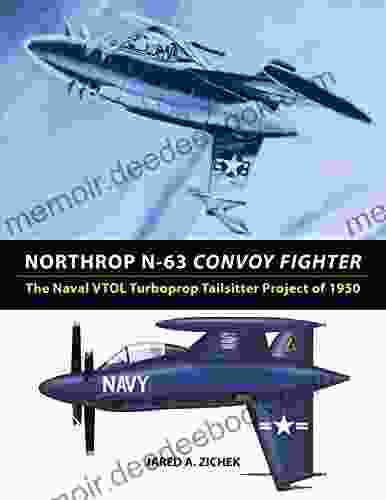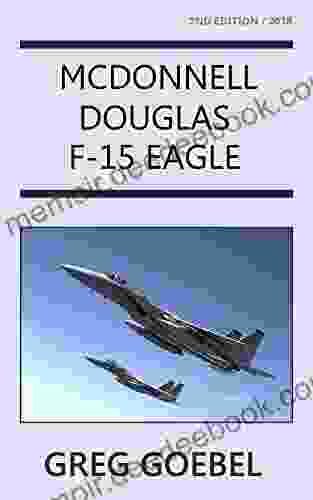Unveiling the Audacious Naval VTOL Turboprop Tailsitter Project of 1950

In the annals of aviation history, the Naval VTOL Turboprop Tailsitter Project stands as a testament to the boundless ambition and ingenuity of engineers during the early days of vertical takeoff and landing (VTOL) aircraft. Initiated by the United States Navy in the 1950s, this revolutionary project aimed to develop a unique aircraft capable of vertical takeoff, hovering, and conventional horizontal flight.
The Concept of Tailsitting
The fundamental concept behind the Tailsitter project lay in its ability to transition between vertical and horizontal flight modes seamlessly. To achieve this, the aircraft employed a unique "tailsitter" configuration. During takeoff and landing, the aircraft rested on its tail, with its nose pointed skyward. This orientation allowed for direct vertical thrust from the engines, enabling the aircraft to rise and descend without the need for a runway.
5 out of 5
| Language | : | English |
| File size | : | 17773 KB |
| Text-to-Speech | : | Enabled |
| Screen Reader | : | Supported |
| Enhanced typesetting | : | Enabled |
| Word Wise | : | Enabled |
| Print length | : | 84 pages |
| Lending | : | Enabled |
Engine Design and Configuration
The heart of the Tailsitter's propulsion system was a pair of powerful turboprop engines. These engines were mounted on either side of the fuselage, providing the necessary thrust for vertical flight. To ensure efficient transitioning between vertical and horizontal flight modes, the engines were equipped with variable-pitch propellers. During vertical takeoff and landing, the propellers were pitched to provide downward thrust, while in horizontal flight, they were pitched to generate forward propulsion.
Body Design and Features
The Tailsitter's fuselage was designed to be lightweight and aerodynamically efficient. The aircraft featured a sleek, streamlined shape, with a rounded nose and a tapered tail section. The wings were located in a mid-mounted position, providing stability and control during horizontal flight. To enhance maneuverability, the aircraft was equipped with ailerons, elevators, and rudders, which were controlled through a fly-by-wire system.
Flight Characteristics and Performance
The Tailsitter's unique configuration granted it exceptional flight characteristics. During vertical takeoff, the aircraft ascended directly upward with a high rate of climb. Once it reached a desired altitude, it transitioned into horizontal flight by gradually tilting forward. The variable-pitch propellers automatically adjusted to provide optimal thrust for each flight mode.
In horizontal flight, the Tailsitter exhibited impressive speed and maneuverability. It could reach speeds of up to 600 miles per hour and perform agile turns and rolls. The aircraft's handling qualities were highly praised by test pilots, who noted its precise control and responsive flight characteristics.
Applications and Potential
The Navy envisioned a range of potential applications for the Tailsitter, including anti-submarine warfare, reconnaissance, and close air support. Its ability to take off and land vertically made it ideal for operating from ships or confined spaces. The aircraft's high speed and maneuverability would have given it a significant advantage in various combat scenarios.
Challenges and Limitations
Despite its innovative design, the Tailsitter project faced several challenges. The complex transition between vertical and horizontal flight modes required precise coordination and control. The aircraft's weight and complexity presented engineering challenges, and its limited range and endurance hindered its operational effectiveness.
Legacy and Impact
Although the Tailsitter project never entered production, its legacy continues to inspire aviation engineers. The pioneering concepts and technologies developed during the project paved the way for future VTOL aircraft, including the Harrier Jump Jet and the F-35B Lightning II.
The Naval VTOL Turboprop Tailsitter Project of 1950 stands as a bold and innovative chapter in aviation history. It showcased the ingenuity and ambition of engineers who dared to push the boundaries of aircraft design. While the project ultimately fell short of its intended goals, it laid the groundwork for future advancements in VTOL technology and remains a testament to the indomitable spirit of exploration and innovation in aviation.
5 out of 5
| Language | : | English |
| File size | : | 17773 KB |
| Text-to-Speech | : | Enabled |
| Screen Reader | : | Supported |
| Enhanced typesetting | : | Enabled |
| Word Wise | : | Enabled |
| Print length | : | 84 pages |
| Lending | : | Enabled |
Do you want to contribute by writing guest posts on this blog?
Please contact us and send us a resume of previous articles that you have written.
 Book
Book Novel
Novel Page
Page Genre
Genre Reader
Reader Magazine
Magazine Newspaper
Newspaper Paragraph
Paragraph Bookmark
Bookmark Shelf
Shelf Bibliography
Bibliography Foreword
Foreword Synopsis
Synopsis Annotation
Annotation Footnote
Footnote Tome
Tome Bestseller
Bestseller Classics
Classics Autobiography
Autobiography Reference
Reference Dictionary
Dictionary Thesaurus
Thesaurus Narrator
Narrator Resolution
Resolution Librarian
Librarian Catalog
Catalog Card Catalog
Card Catalog Periodicals
Periodicals Research
Research Lending
Lending Academic
Academic Journals
Journals Reading Room
Reading Room Special Collections
Special Collections Interlibrary
Interlibrary Thesis
Thesis Reading List
Reading List Book Club
Book Club Theory
Theory Textbooks
Textbooks Michelle Turner
Michelle Turner Susan Chernak Mcelroy
Susan Chernak Mcelroy J R Parks
J R Parks Thomas R Horn
Thomas R Horn Susanna Centlivre
Susanna Centlivre Caddy Rowland
Caddy Rowland Lauren Berry
Lauren Berry Vivien Prideaux
Vivien Prideaux G B Trudeau
G B Trudeau Colin Bentley
Colin Bentley Ivanil Nunes
Ivanil Nunes Paolo Castelnuovo
Paolo Castelnuovo Stephen A Mitchell
Stephen A Mitchell Ann Hunter
Ann Hunter Guy Gavriel Kay
Guy Gavriel Kay Barry Hollembeak
Barry Hollembeak Tori Chase
Tori Chase Dmitry I Ignatov
Dmitry I Ignatov Katherine Hastings
Katherine Hastings Jean Kwok
Jean Kwok
Light bulbAdvertise smarter! Our strategic ad space ensures maximum exposure. Reserve your spot today!

 Ken SimmonsTwelve Months, Four Dogs, and Me: An Unforgettable Journey of Discovery and...
Ken SimmonsTwelve Months, Four Dogs, and Me: An Unforgettable Journey of Discovery and... Christian CarterFollow ·6.7k
Christian CarterFollow ·6.7k Gary CoxFollow ·6.4k
Gary CoxFollow ·6.4k Lord ByronFollow ·18k
Lord ByronFollow ·18k Derek CookFollow ·4.4k
Derek CookFollow ·4.4k Thomas PynchonFollow ·14.8k
Thomas PynchonFollow ·14.8k Dustin RichardsonFollow ·18.2k
Dustin RichardsonFollow ·18.2k Terence NelsonFollow ·4k
Terence NelsonFollow ·4k Tyler NelsonFollow ·7.9k
Tyler NelsonFollow ·7.9k

 Vernon Blair
Vernon BlairHow to Get a Woman to Pay for You: A Comprehensive Guide...
In the modern dating...

 Levi Powell
Levi PowellPrinciples and Theory for Data Mining and Machine...
Data mining and machine learning are two...

 Andrew Bell
Andrew BellMirrors For The Mind: Milestones In Discovery And...
Mirrors have been a part of human history...

 Alec Hayes
Alec HayesDelving into Natural Language Processing with Java and...
Natural Language Processing (NLP) is an...
5 out of 5
| Language | : | English |
| File size | : | 17773 KB |
| Text-to-Speech | : | Enabled |
| Screen Reader | : | Supported |
| Enhanced typesetting | : | Enabled |
| Word Wise | : | Enabled |
| Print length | : | 84 pages |
| Lending | : | Enabled |














